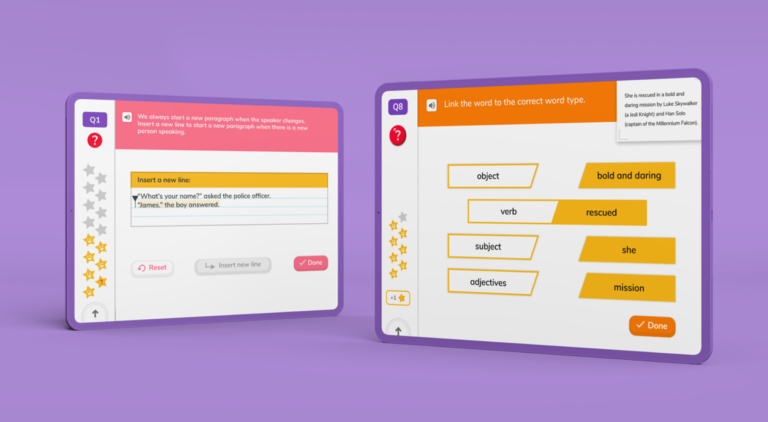Key takeaways
Table of contents
Using phonics is a skill that many of us use regularly without even thinking about it! When we come up against a word we’re unfamiliar with, we use individual letters or groups of letters within the word to sound it out (or decode it).
Essentially, this is what the Phonics Screening Check tests our little ones! The assessment is used to check if they’ve achieved an age-expected understanding of this skill and if they can apply it to read unfamiliar words.
The assessment is administered to students at the end of Year 1, and in some cases, the end of Year 2 instead. Read on to learn more about this assessment and how you can help prepare your learner!
This guide contains some phonics words and phrases that you might not be familiar with, but our phonics key terms glossary will keep you right.
The purpose of the Phonics Screening Check is to test learners’ ability to read, decode, and sound out familiar and unfamiliar words. To do this, they’ll need to have a good grasp of their phonics!
Across the test, our Year 1 pupils will be tested on their understanding of grapheme-phoneme correspondences (how written letters correspond to spoken sounds). This is an important initial skill they’ll need to develop their reading fluency and spelling abilities.
After a quick practice question, students will begin their Phonics Screening Check. They’ll complete two sections each with 20 words, which will increase in difficulty as they go on. Let’s take a closer look at what phonics skills will be covered in each section.
This section will include words with simple structures (e.g. CVC, CCVC, CVCC, and VCC). Students will be tested on:
In the second half of the phonics screening test, students will decode longer and more complex words (e.g. CCCVC, CCVCC, etc.), including two-syllable words. In addition to the criteria above, these words can also test students on:
Of the 40 words students will be asked to read, 40-60% will be pseudo words; fake words used to test pupils’ ability to read unfamiliar words. They might resemble real words, but they’ll be completely new to all students, helping eliminate any bias within the assessment.
The test will be administered in a one-to-one setting, and the child will be asked to read words and pseudo words from the test booklet. The teacher will then record whether their pronunciation was correct or incorrect on a separate answer page.
It’s also worth noting that the test isn’t timed, but students should be able to complete it in under 10 minutes.
Unlock unlimited English questions
Put your skills to the test with fun exercises + learning games that are proven to boost ability!
Looking for more phoincs practice? DoodleLearning is an award-winning English app that’s filled with thousands of questions and games aligned to the national curriculum!
Designed by teachers, it creates each child a unique work programme tailored to their needs, doubling their progression with just 10 minutes of use a day.* Try it for free!

*Based on children earning 24 stars a day. Read the full study here.

The administering teacher will mark students’ responses as correct or incorrect as they complete the test. Learners will receive a score out of 40, indicating their ability to decode phonics to the expected level.
Pupils must meet a threshold score to demonstrate that they are working at an age-appropriate level. This score has been set at 32 marks out of 40 for the last five years.
If a Year 1 student doesn’t meet the threshold score, the school will put support in place, and they’ll be able to retake the Phonics Screening Check at the end of Year 2.
Year 1 students who are undertaking the Phonics Screening Check 2026 will do so at some point between the 8th and 12th of June.
If a learner is absent and unable to complete their phonics check during this week, schools are permitted to use the following week to catch up!
The Year 1 Phonics Screening Check assesses if learners understand different phonetic sounds and how these correspond with written letters. This ability is generally a good indicator of how well students are progressing in their reading skills.
Phonics are also a great way to learn spelling! Identifying different sounds by how they are written helps students as they attempt to spell words. They can sound out the word, and then write out the corresponding graphemes for the phonemes they hear.
Identifying students who are struggling and not meeting age-expected standards allows schools to put the correct support in place to help! The aim is to have more children reading competently by the end of Key Stages 1 and 2.
DoodleEnglish is the perfect study companion for the Year 1 Phonics Screening Test. Filled with thousands of reading, grammar, spelling, and punctuation exercises aligned to the national curriculum, learning ‘little and often’ can improve reading and comprehension skills!


One of the best ways that you can prepare your kiddo for their upcoming phonics check is to read, read, and read some more! Whatever they’re reading, read with them and help them break down tricky words into different sounds.
Fitting some reading time into your little one’s day could look like reading a story together at bedtime, reading with the shopping list at the supermarket, or reading a menu at a restaurant.
Another super opportunity to prepare them is to ask them to spell out some words for you. Encourage your learner to sound out the word before they write it down. Once they’ve finished, ask them to go through the words they’ve written down and sound them out to you!
Playing games is also a brilliantly fun way for kiddos to practice their reading and phonics skills. Why not try out some of these amazing phonics games with your learner? They don’t require much prep and are perfect for a quick practice session!
If your little one loves interactive games, then you could be onto a winner with our DoodleLearning English app! The app is packed with curriculum-linked games that’ll adapt to your learners’ skill level, boosting their confidence and helping them master those all-important phonics skills.
A great way to get your learner ready for their upcoming Phonics Screening Check is to let them have a go at some official phonics screening past papers. These papers will familiarise your kiddo with the exact format of the test and the look of the test paper that they’ll be reading from.
Previous years’ phonics screening past papers and marking guidance are available for 2023, 2024, and 2025.
Using a combination of the strategies we’ve covered above is sure to keep phonics fun and interesting for your little learners. Between playing phonics games, using our English app, and reading in different settings, they’ll be well on their way to reading fluently without even realising it!
Phonics screening 2026 will take place in schools throughout the week beginning 8th June 2026. Schools can also use the following week to catch up on assessing any students who were absent the previous week.
Students will usually sit the Phonics Screening Check at the end of Year 1. In some cases, there may be children who will take the test at the end of Year 2.
Children might take the test in Year 2 if they didn’t meet the threshold at the end of Year 1 or didn’t sit the test in Year 1.
The threshold for meeting the expected standard of the Phonics Screening Check has been 32 out of 40 for the last four years. Historically, the threshold has been set between 30 and 32 marks, and guidance will be published on 22nd June 2026, indicating the threshold mark for this year’s assessment.
Lesson credits

Mhairi Sim
Mhairi is an experienced teacher, freelance writer and parent. After completing her bachelor's degree in Psychology, she graduated as a teacher from the University of Strathclyde. She then built experience teaching across KS1 and KS2 throughout the UK. In addition to working in mainstream education, Mhairi specialised in the additional support needs sector, including social, emotional, and behavioural support.

Mhairi
Mhairi is an experienced teacher, freelance writer and parent. After completing her bachelor's degree in Psychology, she graduated as a teacher from the University of Strathclyde. She then built experience teaching across KS1 and KS2 throughout the UK. In addition to working in mainstream education, Mhairi specialised in the additional support needs sector, including social, emotional, and behavioural support.
Book a chat with our team
If you’d like to use Doodle’s browser version, please visit this page on a desktop.
To log in to Doodle on this device, you can do so through our apps. You can find out how to download them here: